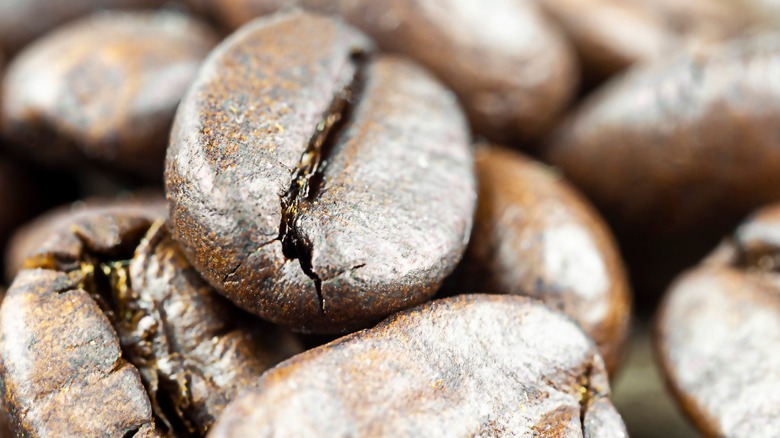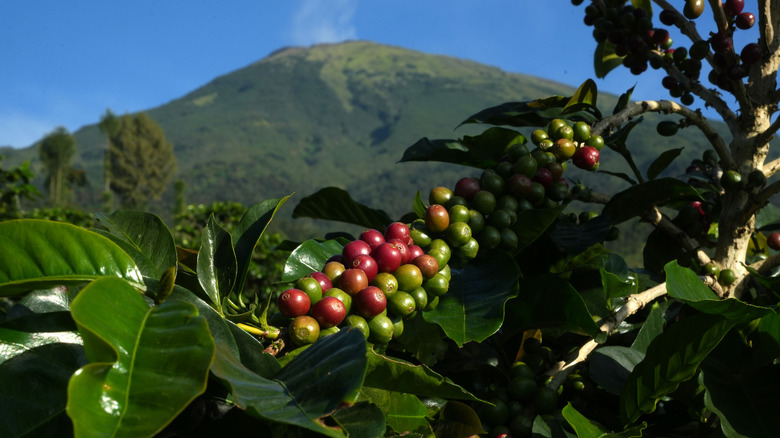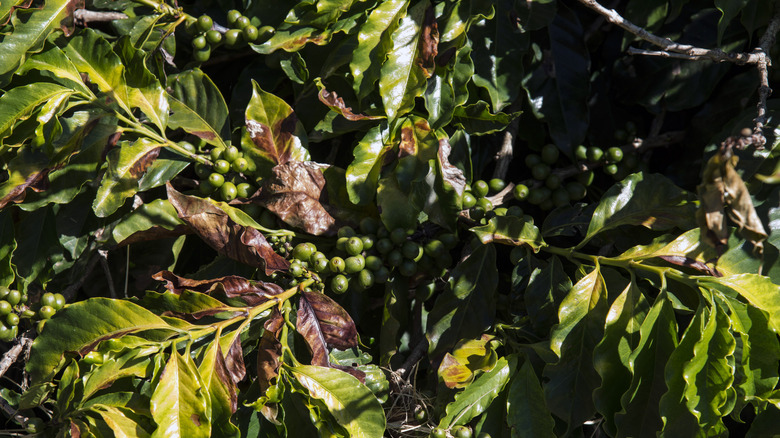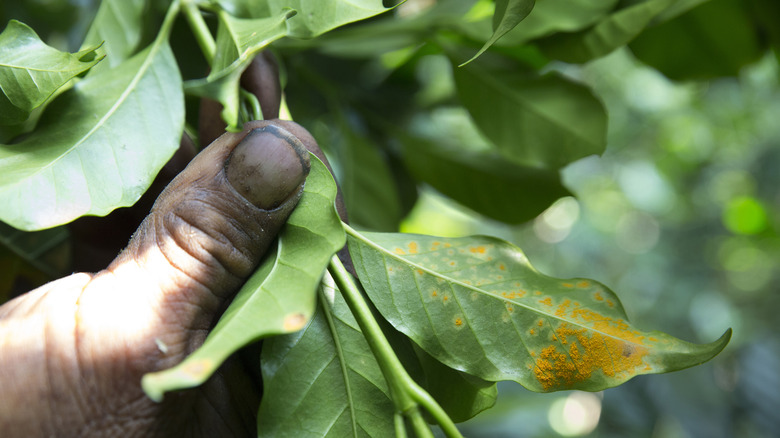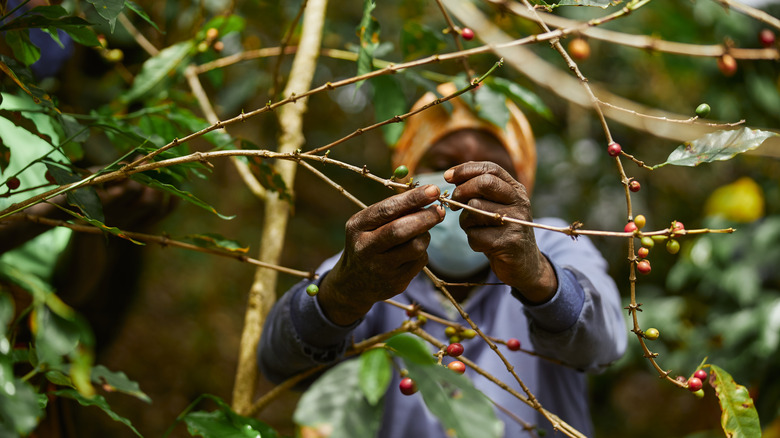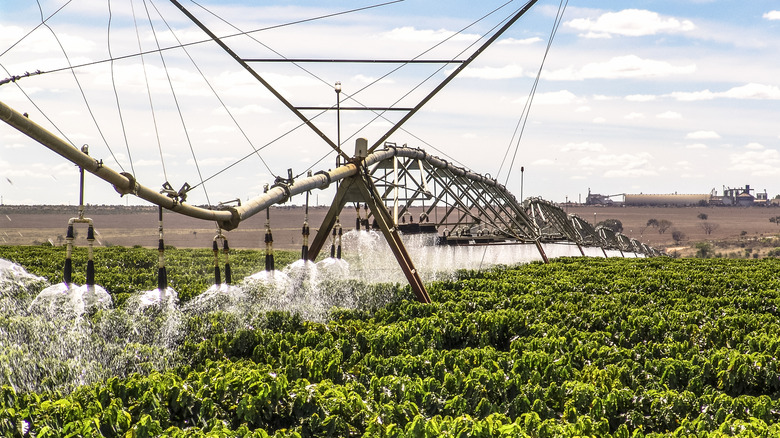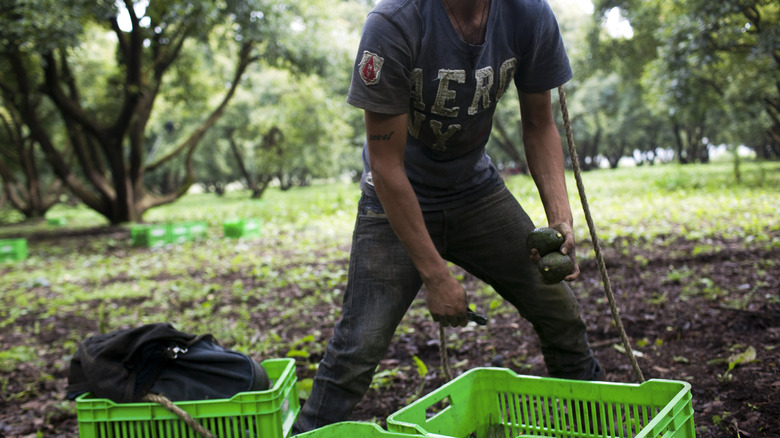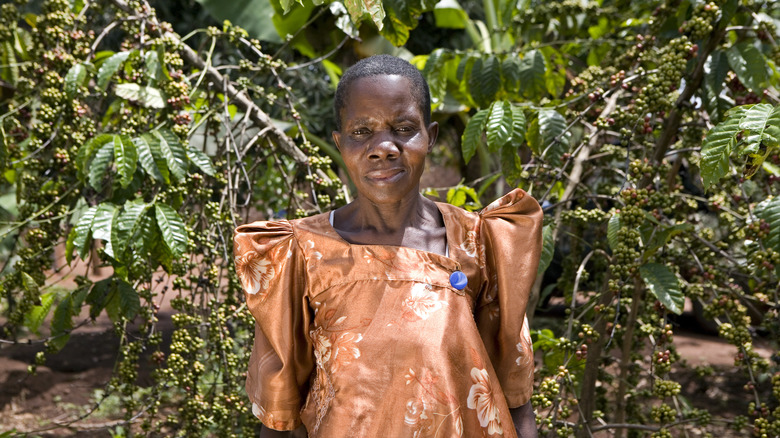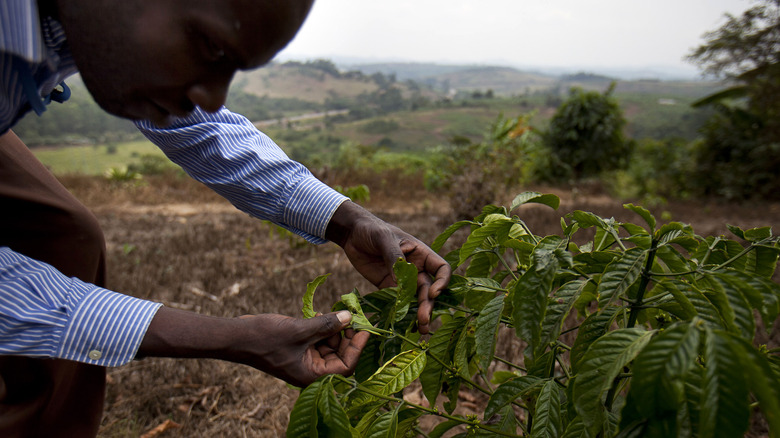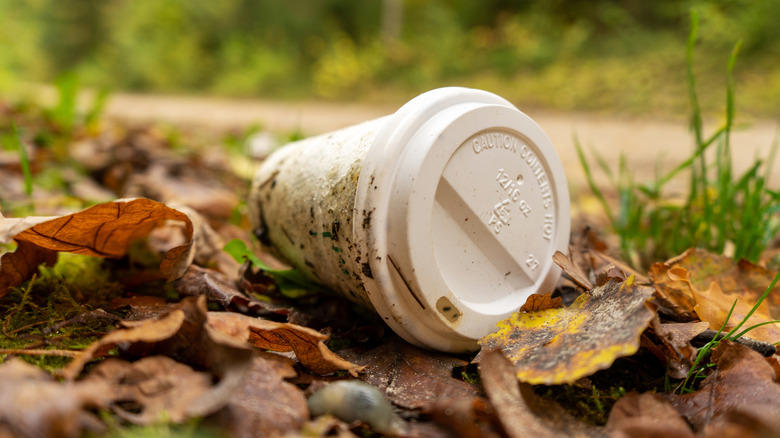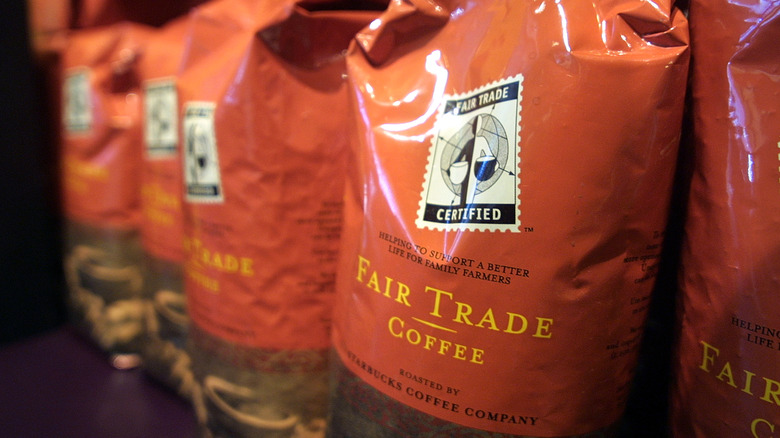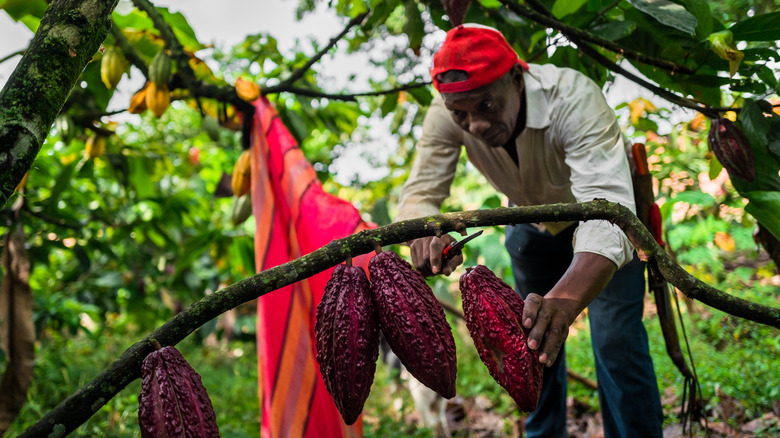How Climate Change Is Affecting Coffee Production, According To Omar El Akkad
Most of us don't think twice about grabbing a cup of coffee from the corner Starbucks on the way to work in the morning. But what would the world look like without your favorite Indonesian dark roast? Although it might seem apocalyptic for a caffeine-dependent life-form like yourself, thinking about a world without coffee is a very real reality for coffee producers, roasters, retailers — and podcaster Omar El Akkad.
El Akkad, a best-selling author, and journalist, hosts "Without," a podcast exploring what the world would look like without some of the most integral material parts of human existence. Each episode is tied together with a common theme and motivating (or, in this case, dis-motivating) factor: Climate change. Throughout the series, El Akkad explores how a rapidly warming world is changing the landscape of these materials and commodities and what the world may look like without their existence due to climate-related disruptions. His reporting reflects the physical changes to coffee production and the reverberating impacts on equity and a population craving caffeine.
The coffee belt will be especially impacted by climate change
The environments where coffee is grown are not only some of the most environmentally fragile places on planet Earth but also some of the regions with the highest rates of poverty, inequity, and political instability. Of the estimated 120 to 125 million individuals that depend on coffee for their livelihoods, nearly 25 million are growers living in the tropics, per Merchants of Green Coffee.
The "coffee belt" spans 25 degrees north of the equator and 30 degrees south, covering most tropical countries, including Brazil, Kenya, Madagascar, Vietnam, Costa Rica, and Nicaragua. These are the most suitable environments for growing coffee because of the mild temperatures, high humidity, and regular rainy season. Many countries within this belt also have both high and low elevations suitable for growing a range of coffee cultivars, including the two most popular: Robusta and Arabica.
Depending on the climate model, scientists expect that the coffee belt region will experience an increase in overall temperatures, less predictable rainfall patterns, and increased instances of natural disasters like hurricanes. These climactic changes impact human populations in these regions and the export-dominant economies that are a key component of global commerce.
Big weather changes are bad news for coffee
To understand why weather impacts coffee so much, you have to know a little bit about the biology of the coffee plant. Omar El Akkad explains, "These are fairly delicate crops, they're very fragile ... they can only be grown at certain elevations, certain temperatures, and certain natural conditions." According to an article published by the National Oceanic and Atmospheric Administration (NOAA), Arabica coffee cannot tolerate mean annual temperatures above 73 degrees Fahrenheit. If the plant is exposed to temperatures higher than 86 degrees Fahrenheit, it can cause plant damage, stunted growth, and stem tumors.
Farmers are already seeing the impacts of a warmer climate on the Arabica bean, and warmer temperatures are yet to come. "We found estimates from scientists that over the next three decades, something like 60% of the land that Arabica is grown on will become unstable for growing the crop," El Akkad adds. Climate change doesn't just impact cultivated species, either. A 2019 report published in ScienceAdvances notes that 60% of wild coffee species are expected to go extinct due to climate change, deforestation, habitat loss, and unsustainable agricultural methods.
Climate change is linked with coffee diseases and pests
Omar El Akkad notes that one of the surmounting threats to the coffee industry is persistent diseases like coffee rust. Coffee rust is a fungus that thrives in warm, wet conditions. It causes yellow and brown spotting on the leaves at first, along with a characteristic yellow rust on the underside of the leaf, before it starts to defoliate and kill the plant entirely.
According to reporting from The Atlantic, coffee rust cost farmers an estimated $3 billion in damage and loss between 2012 and 2017 and caused nearly two million farmers to leave the industry altogether. Besides the disease thriving in altered weather conditions, coffee farmers also have to contend with a disease that has become more resistant to fungicides than ever before.
Along with rust, there is the challenge of coffee berry borers, which can be found in all coffee-growing regions worldwide besides China and Nepal. According to research published in Insects, the beetle has already cost more than $500 million in damage yearly, and scientists note that the populations of beetles are moving northward in elevations with rising temperatures.
Climate change will exacerbate financial stress on growers
Omar El Akkad notes that one of the reasons climate change is particularly threatening to the coffee industry is the massive disparities in the market prices that consumers pay for coffee products compared to the prices that producers earn. He cites the example of a subspecies of Arabica coffee grown in Vietnam. The coffee beans fetched nearly $46 per kilo when sold at a boutique coffee shop, but the farmer only earned about $0.68 per kilo.
"We looked at the commercial side of it because coffee is one of those commodities where there is a massive, massive discrepancy between how much money the high-end boutique is making when you go buy a cup of coffee from them and how much money the farmer on the other side of it is making when they first produce this crop," El Akkad explains.
Research from Enveritas supports this, noting that of the 12.5 million smallholder coffee farmers globally, 5.5 million live below the international poverty line and make less than $3.20 daily. Farmers who are more deeply entrenched in poverty lack the financial resources to adapt to climate change and are not as malleable to minor fluctuations in coffee prices. In turn, climate change will further exacerbate poverty for these populations.
Farmers are trying to adapt to climate change
The climate change discussion is interlaced with two important questions: "How can we mitigate the causes of climate change in the present?" and "What kind of adaptations can civilization make to accommodate a changing climate?" The former is a much more complicated question and will rely on scientifically-informed policies, incentives, and regulations. But, as far as adaptation strategies go, coffee is at the forefront.
One of the most widespread adaptations being made for coffee farmers is to travel upwards in elevation to regions where coffee can be more suitably grown. However, this is still a fraught movement for many farmers, especially considering that a coffee plant takes several years to become productive. The movement upwards in elevation will also mean clearing out new land for the plantations, which disrupts biodiversity and habitat and contributes to the negative feedback loop between climate change and deforestation.
The other alternative for farmers is to adopt new technologies that will better allow them to control the temperatures and conditions the coffee is grown in. Omar El Akkad notes that irrigation, solar-powered farms, and even shade-grown coffee, which act as a buffer for coffee's microclimate and can regulate pest prevalence, are not accessible to all farmers.
If farmers can't adapt, they have to grow something else
One of the biggest trends Omar El Akkad found in researching for his podcast "Without" was the number of people leaving the coffee industry to grow more predictable crops. "[Coffee] becomes more and more difficult to grow, and it becomes less certain what every year's crop is going to be. A lot of small farmers are moving to other crops."
In his interviews with farmers from Vietnam, El Akkad learned that of the 35,000 farmers growing Arabica in the country, 15,000 have left to grow other crops like macadamia nuts. The movement out of Arabica growing has further increased the price of coffee because of diminished production and caused price fluctuations in the other commodities farmers have moved to. One study published in Scientific Reports indicates that half of the coffee plantations in Central and South America could be replaced with cacao. Avocados and other fruit-bearing plants may also replace coffee in the future.
Climate change will disproportionately impact women in the coffee industry
Climate change is not selective to the populations it impacts. But, structural and sociopolitical inequities exist and cause marginalized people to face disproportionate impacts. Women, for example, face numerous obstacles to achieving economic independence and social sovereignty in many regions where coffee is grown. An article published by Coffee Intelligence noted that despite women in Columbia and Uganda completing the majority of fieldwork and coffee cherry processing, the same women are historically excluded from decision-making, land ownership, access to training, and opportunities for connecting to more extensive agribusiness distribution networks.
Because women face significantly more hurdles in achieving equity in agriculture and are often forced to give up some (or most) of their earnings to male landowners or property managers, the reduction in income due to climate change will disproportionately impact women. Omar El Akkad expresses this sentiment. "The 'we,' in terms of who's going to experience this is everybody; if you live on this planet, you are going to experience some facet of climate change. But the 'we' in terms of how you experience it, and the severity, is very, very segmented."
We can expect to see coffee commodity prices to increase
Coffee prices have been "fluctuating wildly" for the past decade, Omar El Akkad notes. These prices are based on production levels, surpluses, and other general economic concepts. And while these immediate factors are playing a role in the present price of coffee, El Akkad instead looks at the price of coffee as a trajectory. "What we're seeing is climate change-related conditions having a bigger impact on the price of the coffee." For example, Robusta coffee prices reached an all-time high in 2023 due to climactic change and the impacts of the El Niño-Southern Oscillation (ENSO). Commodity prices are increasing steadily and are expected to continue to rise within the next decade.
El Akkad explains that it's not just disease and weather that's changing the price of coffee but also the adaptations farmers are taking to remain financially viable. El Akkad notes that as farmers move upwards in elevations to continue growing the crop, the availability of the crop decreases, thus increasing the price. As farmers leave the industry to pursue other commodities like macadamia nuts, the limited supply will further increase prices.
Roasters may not carry the same types of coffee
The availability of certain coffee varieties is on the decline as farmers inevitably go out of business or switch to growing other types of crops. Omar El Akkad notes that coffee consumers will expect to see coffee shops carrying fewer (or different) varieties and increasing the market price of the coffee it's selling. He explains that he learned this while meeting with "small mom-and-pop" roasters and boutiques while producing the coffee episode for his podcast.
Per El Akkad, "It was interesting to see the very different definitions of 'impact.' When we talked to the small farmer in Vietnam, the impact was, 'I quite literally can't make a living growing this crop. I have to find something else to do.'" In comparison, after talking to a high-end coffee retailer, El Akkad noted that the reverberating consequence was that coffee retailers not being able to carry a particular variety of beans. "So we are seeing an impact. We are seeing stores have to make changes, but it's not nearly as existential."
Researchers are looking for new, tolerant varieties
One of the most significant pushes for agricultural scientists is to find hardier varieties than Arabica and Robusta beans, which currently make up nearly all of the current commercial coffee business. New varieties, including Liberica coffee and the temperature-tolerant Coffea stenophylla, which can survive temperatures 11 to 12 degrees Fahrenheit warmer than sensitive Arabica, offer some reprieve for farmers. But the significant barriers to adopting new varieties include changing coffee drinkers' taste away from the familiar flavor of Arabica and developing a market to accommodate it.
El Akkad explains that numerous equity concerns are associated with finding and cultivating these new cultivars, too. "Yes, you have a scientist from the West who's going around a jungle somewhere, literally with a machete, looking to find new variants. But whose land is that? And who's been consulted about that? What happens if they do find a new variant that becomes part of the commercial pipeline? Who's compensated?" These questions are crucial to answer as climate change drives agricultural interests toward new discoveries.
Coffee, and its supply chain, contributes to climate change
Just because coffee is impacted by climate change doesn't mean the relationship is a one-way street. Omar El Akkad shares that, like other types of consumer commodities, coffee has a part in perpetuating climate change and environmental degradation. Coffee plantations, especially those where the land must be clear-cut to grow coffee plants, are a driver of deforestation and habitat loss in fragile environments. Some steps are being made to reduce the environmental footprint of producers, such as cooperative partnerships to promote agroforestry and recycling programs to convert unused coffee husks into fuel. These programs come with both necessary and new technological developments.
However, many industry studies examining the carbon footprint of coffee attempt to put the blame for emissions on growth production, only begrudgingly attributing emissions to transportation and the supply chain. El Akkad points out that it's not so simple. "When you're talking about a small farmer somewhere growing coffee, yeah, there's a climate footprint to that," he says. "But the process of getting that coffee all the way to the other side of the planet and putting it on a shelf in a high-end coffee shop somewhere. That is an entirely different scale of climate impact."
In recent years, many coffee shops have adopted practices to reduce the carbon footprint of their stores by recycling spent beans with gardeners and offering plastic alternatives. Although the impact of individual consumers may be small, it's a step in the right direction.
Labeling can aid climate-friendly coffee, but only in a vaccuum
One of the potential avenues to help consumers to decide what type of coffee to purchase (aside from availability and price) are labels like Fair Trade and Bird-Friendly coffee. These kinds of programs benefit farmers because they pay a premium for coffee, which can increase the income of a farming operation.
With climate change, there is immense market potential for these labels to encourage climate-friendly practices, too — just not "inside a vacuum." On his podcast, "Without," Omar El Akkad comments that these sustainable coffee labels have an "inherent opaqueness" regarding what the claim actually means for consumers. He also explains that there is very little consideration of the entire system when evaluating if a product is "sustainable" or not. For example, a certification program may only look at the type of habitat preservation or irrigation methods a farm uses but not at the entire life cycle of how the coffee is packaged, marketed, sold, and disposed of.
Coffee is just the 'canary in the coal mine'
Omar El Akkad explains that coffee is "the canary in the coal mine of the world at large in relation to climate change." He notes that the same phenomenon happening with coffee — higher prices, lower crop viability, and product instability — is occurring with other "luxury" commodities. These can include wine and cacao. Climate change will also impact staple crops like corn, which is expected to decrease productivity by 7% with a climate warming of 1.8 degrees Fahrenheit (via the Guardian). A corn shortage encapsulates products with corn derivatives, like high fructose corn syrup and starches, and the livestock industry that feeds on it.
It's not just the crops that are being affected by climate change. El Akkad also shares that the climate-driven shortages of the inputs needed to produce these crops, like phosphorous for fertilizers, are compounding the issues with the availability and pricing of the commodities we eat and drink every day.
Coffee isn't going away tomorrow
Omar El Akkad ensures listeners throughout his podcast that the morning cup of joe will not phase out in the immediate future. "It's not the case that we're going to run out of coffee tomorrow. But the trajectory of coffee production is not looking great in the long run." The advancements and adaptations to a warming world aren't just going to be done by scientists, agronomists, and inventors either — consumers will have to adapt their palates and purchases to have their cup of coffee and drink it too.
Throughout our interview, El Akkad reinforced the underlying issues of equity, justice, and bigger questions in transitioning to a warmer planet. He notes that although consumers should care about the price of coffee as "an appeal to self-interest," it might not be the most "morally relevant" component of the discussion. After all, a cup of coffee may soon be considered an indulgence, but it is a livelihood for millions of people worldwide. Omar El Akkad explains, "Really, what we're trying to do more than anything is make people aware that these issues are happening to real human beings, not just abstractions on the other side of the planet."
